Morphology of Flowering Plants Chapter Notes | Biology Class 11 - NEET PDF Download
| Table of contents |

|
| The Root |

|
| The Stem |

|
| The Leaf |

|
| Inflorescence |

|
| The Flower |

|
| The Fruit |

|
| The Seed |

|
| Semi-Technical Description of a Typical Flowering Plant |

|
Flowering plants, scientifically referred to as angiosperms, represent the largest and most varied category of terrestrial plants, comprising around 300,000 identified species. The study of the external form and structure of plants is like exploring and discovering the special features of a plant through its form and appearance. This chapter explains how plants grow, starting with the roots that keep them in the ground, all the way to their beautiful flowers that we love to look at.
Let's study them one by one!
What is Morphology in Flowering Plants?
Morphology is the study of the form and structure of organisms, which includes the external features of plants such as their shapes, sizes, colors, and patterns. In the case of flowering plants, morphology helps in identifying and classifying different species based on their physical characteristics.
- Morphology is the study of the structure and form of organisms, including their external features such as shape, size, color, and pattern.
- In flowering plants, morphology is used to identify and classify different species based on their physical characteristics.
 Morphology of a Flowering Plant
Morphology of a Flowering Plant
The Root
The Root is an essential part of the plant that is responsible for absorbing water and minerals from the soil. These structures play a primary role in securing the plant in the soil and taking up vital minerals, nutrients, and water from the earth. Additionally, roots serve as storage organs for storing nutrients.
(a) Taproot: The primary root is formed by elongation of the radicle and it bears secondary and tertiary roots, present in dicot plants. This root produces lateral roots of various orders, known as secondary, tertiary, and so on. Together, the primary root and its branches form the tap root system.
Example: Gram, mustard, etc.
 Tap Root
Tap Root
(b) Fibrous root: In monocotyledonous plants, the primary root is short-lived and is replaced by a large number of roots that emerge from the base of the stem. This system is known as the fibrous root system.
Example: Rice, wheat, etc.
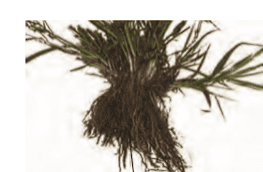 Fibrous Root
Fibrous Root
(c) Adventitious root: Roots produced from parts of the plant other than the radicle. These are called adventitious roots.
Examples: Grass, Monstera, and the banyan tree
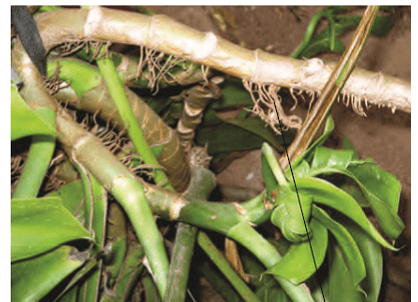 Adventitious Roots
Adventitious Roots
 Main Functions of Root System
Main Functions of Root System
Regions of Root
The structure of a root can be categorized into 4 parts. Each part of the root has a different function. They are as follows:
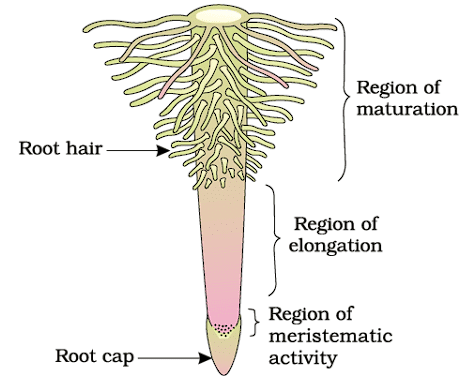 Regions of Root
Regions of Root
- Root Cap: The root apex is covered by a thimble-like structure called the root cap. It acts as a protective cover for the tender tip of the root as it penetrates through the soil.
- Region of Meristematic Activity: Located a few millimeters above the root cap, this region is responsible for the growth in thickness and length of the root. The cells in this region are small, thin-walled, and actively dividing, with dense protoplasm.
- Region of Elongation: Proximal to the region of meristematic activity, the cells in this region undergo rapid elongation and enlargement, leading to the growth of the root in length. This region is responsible for the primary elongation of the root.
- Region of Maturation: The cells of the elongation zone gradually differentiate and mature in this region. It is located proximal to the region of elongation. In this region, some of the epidermal cells differentiate into delicate, thread-like structures called root hairs.
Root Hairs: Root hairs are fine and delicate structures that are formed from the epidermal cells in the region of maturation. They play a crucial role in absorbing water and minerals from the soil, increasing the surface area for nutrient uptake.
Modifications of the Root
- For storage: taproots- carrot, turnip; adventitious roots- sweet potato
- For support: Prop roots of Banyan tree, that arise from branches; stilt root of maize and sugarcane, that comes out of lower stem nodes
- For aeration: pneumatophores present in mangroves help them in respiration as it grow in swampy areas. These roots grow upwards above the ground, e.g. Rhizophora
- For nitrogen fixation: root nodules of leguminous plants
 Modifications of Root
Modifications of Root
The Stem
A stem is the upward part of a plant's axis that supports branches, leaves, flowers, and fruits. It originates from the plumule of a germinating seed's embryo.
- It develops from the plumule of a germinating seed.
- The stem has nodes and internodes. Nodes are where leaves grow, and internodes are the sections between two nodes.
- The stem also has buds, which can be terminal (at the top) or axillary (at the sides).
- When young, the stem is usually green, but it can become woody and dark brown as it matures.
The main Functions of the Stem are
 Functions of Stem
Functions of Stem
Note: To make learning easier and more memorable you can use memory tricks known as mnemonics that help you remember things easily. They work by making information simpler and use shortcuts like acronyms, rhymes, and pictures to make learning fun and effective. Mnemonics reduce the effort your brain needs to remember, making studying easier and more enjoyable.
The link given below will redirect you to an interesting mnemonic document.
Mnemonics-Morphology-of-Flowering-Plants
Modifications of the Stem
(i) Underground Stem: They help plants sustain unfavourable conditions for growth
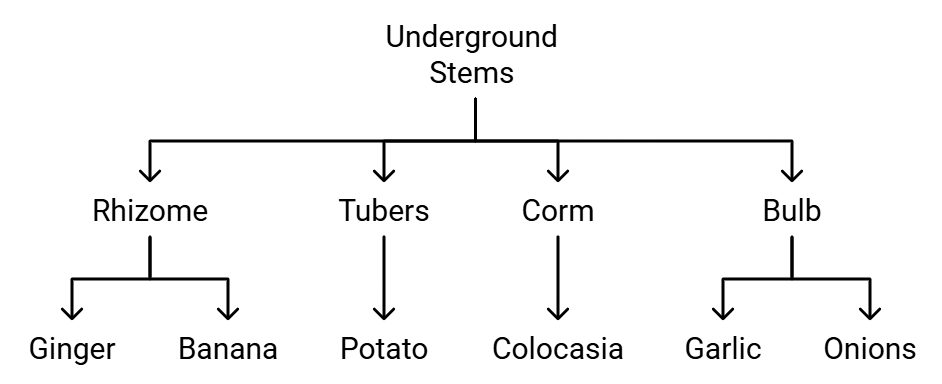 Underground Stem Types and Examples
Underground Stem Types and Examples
- Rhizome- runs parallel to the ground and has nodes, internodes, buds, e.g. ginger, banana
- Tubers- the end part gets swollen as in potato
- Corm- it grows vertically below the ground, e.g. colocasia, etc.
- Bulb- stem is reduced and surrounded by scaly leaves, e.g. garlic, onions
(ii) Stem Tendrils: these are a coiled structure that supports tender stem of the plant and help in climbing, e.g. grapes, cucumber, pumpkin
(iii) Thorn: axillary bud gets modified into pointed thorns and protects plants from grazing animals, e.g. Bougainvillea, citrus
(iv) Subaerial Weak Stem
 Subaerial Weak Stem Types and Examples
Subaerial Weak Stem Types and Examples
- Offsets- internode of lateral branches decreases resulting in the rosette of leaves, e.g. Eichhornia, Pistia
- Suckers- lateral branches arise from the underground portion of the stem, e.g. chrysanthemum, banana, pineapple
- Runners- stem run horizontally above the ground and roots arise at nodes, e.g. grasses, strawberry
- Stolon- lateral branches arise normally but then bend down and touch the soil where the root grows and the new daughter plant arises, e.g. mint
(v) Aerial modification: The stem is completely metamorphosed for various adaptations, e.g. Phylloclade of xerophytic plants. The stem becomes fleshy and green having photosynthetic pigments to prepare food as leaves are reduced to thorns to check water loss by transpiration, e.g. Euphorbia, Opuntia
The Leaf
The leaf is a lateral, generally flattened structure borne on the stem. It develops at the node and bears a bud in its axil. The axillary bud later develops into a branch. They are the most important vegetative organs for photosynthesis.
- Leaves originate from the apical meristem of a shoot and are arranged in an acropetal order.
- Normally a leaf consists of three parts: leaf base, lamina and petiole.
- The leaf base attaches to the stem and may have two small leaf-like structures known as stipules.
Modifications of Leaves
- Tendrils- leaves modified to form a long thread-like structure, it gives support to climbers.
Example: Peas. - Spine- in xerophytic plants to reduce water loss.
Example: Cactus, aloe. - For storage- e.g. garlic, onion
- Phyllodes- petiole gets modified to form a leaf-like structure and function, e.g. Acacia
- The pitcher in a pitcher plant is a modified leaf that traps insects inside
(a) Venation
Venation refers to the arrangement or pattern of veins in the leaves of plants, typically seen when observing the leaf's surface.
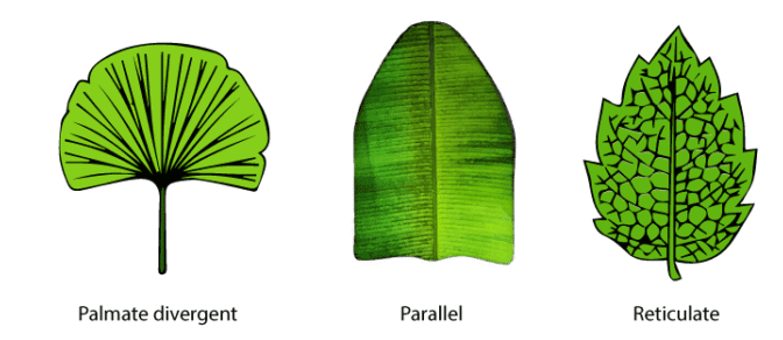 Venation in Leaves
Venation in Leaves
Types of Venation
- Palmate Venation: In this type of venation, the lamina has more than one principal vein.
- Parallel Venation: It is present in monocotyledons, and veins are parallel to each other.
- Reticulate Venation: It is present in dicotyledons, there is a network of veins present, which are irregularly distributed.
(b) Types of Leaves
There are mainly two different types of leaves – simple leaves and compound leaves.
(i) Simple Leaves: In this type of leaf, the lamina is complete and the incision doesn’t reach the midrib.
(ii) Compound Leaves: incision touches midrib, which divides a leaf into a number of leaflets.
The two sub-types of compound leaves are as follows:
- Pinnately compound: Leaflets are present on the common axis, i.e. midrib, called the rachis.Example: Neem.
- Palmately compound: Leaflets are attached at the petiole tip.
Example: Silk cotton.
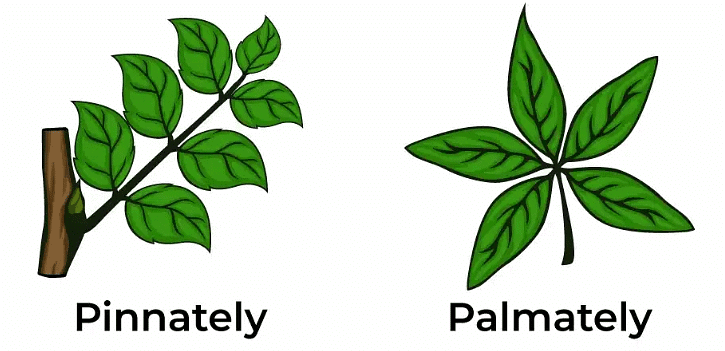 Pinnately and Palmately Compound Leaves
Pinnately and Palmately Compound Leaves
(c) Phyllotaxy
Phyllotaxy refers to the arrangement pattern of leaves on the stem or branch of a plant. It plays a role in optimizing light exposure and efficient use of space for plant growth and development.
It can be categorized into three main types: alternate, opposite and whorled:
 Types of Phyllotaxy
Types of Phyllotaxy
(i) Alternate Phyllotaxy: In this type of phyllotaxy, a single leaf arises at each node of the stem or branch in an alternate manner. This means that the leaves are not directly opposite to each other, but instead are positioned one after the other.
Example: China rose, mustard and sunflower.
(ii) Opposite Phyllotaxy: In opposite phyllotaxy, a pair of leaves arises at each node and lies opposite to each other. This means that two leaves are positioned directly across from each other on the stem or branch.
Example: Calotropis and guava.
(iii) Whorled Phyllotaxy: In whorled phyllotaxy, more than two leaves arise at a single node and form a whorl-like arrangement around the stem or branch. This means that multiple leaves are positioned in a circular or whorl-like pattern at a single node.
Example: Alstonia.
Inflorescence
A flower is a modified shoot, where the shoot apical meristem changes into a floral meristem. Internodes don't lengthen, and the axis becomes compact. The apex generates various floral structures at successive nodes instead of leaves. When a shoot tip becomes a flower, it is always solitary.
The organization of flowers on the floral axis is called an inflorescence.
The two main types of inflorescence are:
(i) Racemose: the main axis grows indefinitely, flowers are present laterally in acropetal succession i.e. older flowers at the bottom and the younger ones at the top.
(ii) Cymose: the main axis terminates in flower and has limited growth. Flowers are borne in a basipetal order i.e. older flowers are at the top and new flowers are at the bottom.

Types of Racemose and Cymose Inflorescence
(i) Racemose: Types of racemose inflorescence: raceme, spike, umbel, capitulum, corymb, catkin, spadix, etc.
(ii) Cymose: Types of cymose inflorescence: monochasial cyme, dichasial cyme, etc.

(f) Special Types of Inflorescence
(i) Verticillaster: sessile flowers arranged in dichasial cyme.
Example: Ocimum, Salvia.
(ii) Cyathium: involucre of bracts form cup shape structure, single female flower is surrounded by numerous male flowers.
Example: Euphorbia.
(iii) Hypenthodium: both male and female flowers are present in a cavity with an apical opening called the ostiole.
Example: Fig.
The Flower
A flower is defined as the reproductive structure in flowering plants (angiosperms) that is responsible for the production of seeds. It is a specialized shoot consisting of modified leaves arranged in a specific pattern.
Flower Symmetry
Flower symmetry, also known as floral symmetry refers to the arrangement of floral parts (such as petals, sepals, and other structures) around the central axis of a flower.
Flower symmetry is classified into three types:
(i) Actinomorphic: They are radially symmetrical flowers.
Example: Chilli, datura, and mustard.
(ii) Zygomorphic: When a flower can be divided into two equal parts in only one vertical plane (bilaterally symmetrical).
Example: Cassia, pea, etc.
(iii) Asymmetric: Flowers with asymmetry lack any clear pattern of symmetry and do not exhibit mirror-image symmetry along any plane. Asymmetric flowers do not have equal parts when divided along any axis.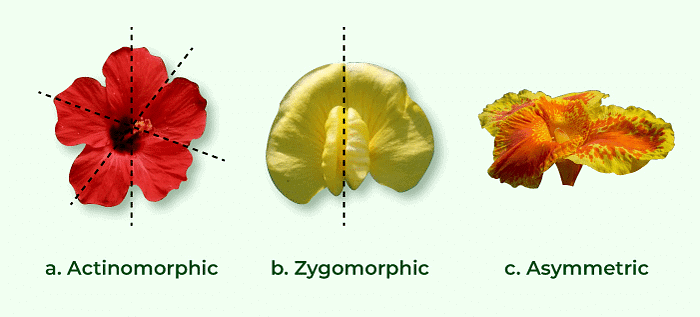
Types of flowers based on the number of parts of a flower can be: trimerous, tetramerous and pentamerous depending on the multiple of floral appendages present 3, 4 or 5.
Types of flowers based on the presence or absence of bracts (reduced leaf present at the base of pedicel) can be Bracteate or Ebracteate.
Types of flowers based on the position of the ovary, a flower can be:
(i) Hypogynous: Gynoecium occupies the highest place, above all the other parts. The ovary is known as superior.
Example: Brinjal, china rose, mustard.
(ii) Perigynous: Gynoecium is present at the same level as the rest of the parts of a flower. The ovary is known as half inferior.
Example: Peach, plum, rose.
(iii) Epigynous: Thalamus encloses the ovary completely and other parts are present above it. The ovary is known as inferior.
Example: Ray florets of a sunflower, guava, cucumber.
 |
Download the notes
Chapter Notes: Morphology of Flowering Plants
|
Download as PDF |
Parts of a Flower
A flower has four whorls: calyx, corolla, androecium and gynoecium. These are attached to the swollen terminal of pedicel called the thalamus.
Parts of a flower are as follows:
(i) Calyx: A flower’s outermost whorl is made up of leaf-like structures called sepals.
Types of Calyx
There are two types of calyx. They are as follows:
- Gamosepalous: This term refers to sepals that are fused or united, forming a single structure.
- Polysepalous: This term refers to sepals that are free or separate from one another.
(ii) Corolla: It is made up of bright-coloured petals. Present after sepals.
Types of Corolla
- Gamopetalous: This term refers to those petals that are fused or united to form a single structure.
- Polypetalous: This term refers to those petals that are free or separate from each other.
Aestivation
It is the mode of arrangement of sepals and petals. This folding or arrangement occurs to protect the delicate floral parts or leaves from adverse environmental conditions such as extreme temperatures, excessive sunlight, or water scarcity.
The main types of aestivation are:
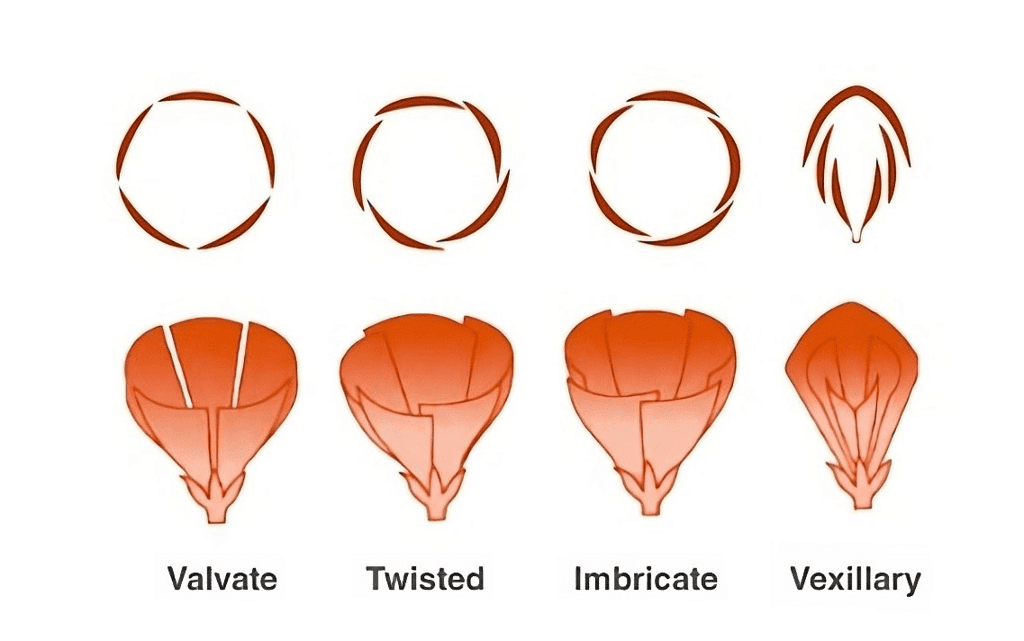 Types of Aestivation
Types of Aestivation
- Valvate: Sepals or petals just touch each other and don’t overlap in a whorl.
Example: Calotropis. - Twisted: Sepal or petal overlaps the next sepal or petal and the same continues in a whorl.
Example: Cotton, china rose, lady’s finger. - Imbricate: Margins of sepal and petals overlap each other randomly and not in one direction. Example: Gulmohar, Cassia.
- Vexillary: The largest petal overlaps two petals (wings) present laterally on both the sides and that overlaps the two anterior petals (keel) in the same way. It is also called papilionaceous.
Example: Beans, peas.
(iii) Androecium: It is a male reproductive part. It consists of stamens. Each stamen is made up of filament and anthers.
 Types of Androecium
Types of Androecium
- Staminode- In this type of androecium, stamen are sterile.
- Epipetalous- In this type of androecium, stamen are attached to petals.
- Polyandrous- In this type of androecium, stamens are free.
- Monadelphous- In this type of androecium, stamens are united and present as one bundle.
- Diadelphous- In this type of androecium, stamens are united and present in two bundles.
- Polyadelphous- In this type of androecium, stamens are united and present in more than two bundles.
(iv) Gynoecium: It is a female reproductive part. It consists of carpels. Each carpel has three parts: stigma, style and ovary.
Types of Gynoecium
- Apocarpous: In this type of gynoecium, more than one carpels present, which are free.
Example: Rose, lotus. - Syncarpous: In this type of gynoecium, more than one carpels present, which are united.
Example: Tomato, mustard.
Placentation
Placentation is the arrangement and positioning of ovules within the ovary of a flowering plant. The ovules are typically connected to the ovary through a structure called the funicle, and they attach to a specialized region of the ovary known as the placenta. This arrangement is crucial for seed development and eventual fruit formation.
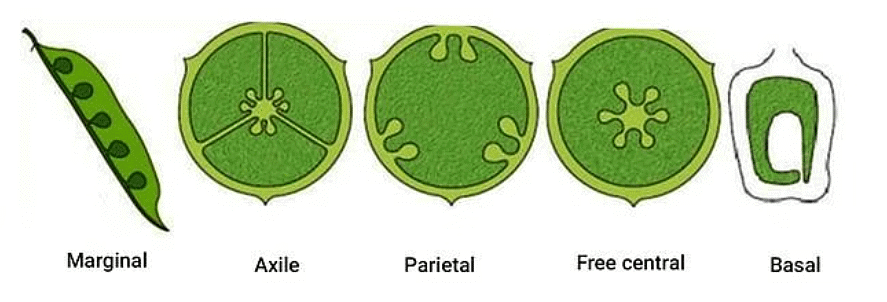 Types of Placentation
Types of Placentation
Types of Placentation
(i) Marginal Placentation: In this type, the ovules are attached to the inner wall of the ovary along the margin or edge, forming a single line.
Example: Pea.
(ii) Axile Placentation: In this type, the ovules are attached to a central column or axis within the ovary. The ovules are attached in a radial or symmetrical pattern along this central axis.
Example: Lemon, china rose.
(iii) Parietal Placentation: In this type, the ovules are attached to the inner wall (parietal wall) of the ovary. They are typically arranged in a single or multiple rows along the inner surface of the ovary.
Example: Argemone, mustard.
(iv) Free Central Placentation: It is characterized by a central column within the ovary to which the ovules are attached. The ovules are attached to a central axis, and the partitions between them do not reach the center.
Example: Primrose, Dianthus.
(v) Basal Placentation: In this type, the ovules are attached at the base or bottom of the ovary. In this type, a single ovule or a group of ovules is attached at the base of the ovary.
Example: Marigold, sunflower.
The Fruit
The fruit is a characteristic feature of the flowering plants. It is a mature or ripened ovary, developed after fertilisation.
- Parthenocarpic fruit: The fruit formed without fertilisation, it makes seedless fruits.
Example: Pineapple. - Seed and pericarp make a fruit. The fleshy pericarp is made up of three layers: epicarp, mesocarp and endocarp
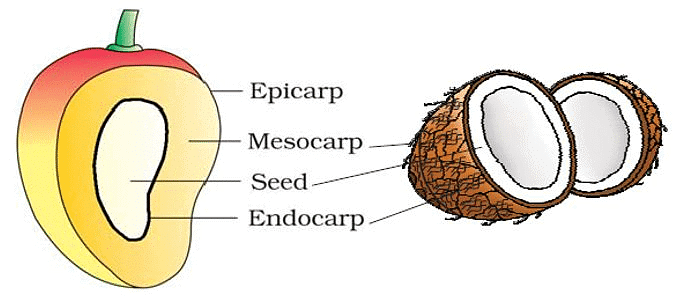 Parts of Fruit
Parts of Fruit
The Seed
After the fertilisation, the ovule develops into a seed. Seeds are crucial for the propagation and continuation of plant species.
- A seed has a seed coat and an embryo.
- An embryo is made up of radicle, embryonal axis and one or two cotyledons in monocotyledons (maize, wheat) and dicotyledons (pea, gram) respectively.
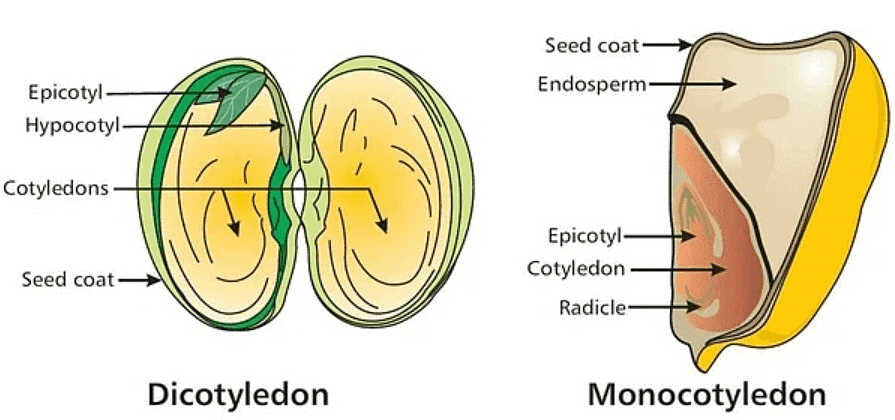 Types of Seed
Types of Seed
Difference between dicotyledenous and monocotyledenous seeds are as follows:
 Difference between Dicot Seed and Monocot Seed
Difference between Dicot Seed and Monocot Seed
Semi-Technical Description of a Typical Flowering Plant
- For easy identification and classification, a flowering plant’s description contains vegetative and floral traits, the floral formula, and a floral diagram.
- A flowering plant’s technical description must be written in scientific language and must be basic, concise, and sequential.
- A flower’s symmetry, sex, calyx, corolla, perianth, androecium, gynoecium, bracts, bracteoles, staminodes, pistillodes, and the number of sepals, petals, stamens, and carpels are all represented by a series of symbols in the floral formula. With the use of symbols, the formula also explains cohesion and adhesion inside parts of the whorls and between whorls.
- In most cases, the floral formula is accompanied by a floral diagram. The floral diagram depicts a flower’s cross-section and includes data on sex, symmetry, bracts, bracteoles, and the number of floral whorls.
- Floral symbols are represented in the following chart:

The following floral diagram with floral formula represents the mustard plant (Family: Brassicaceae):
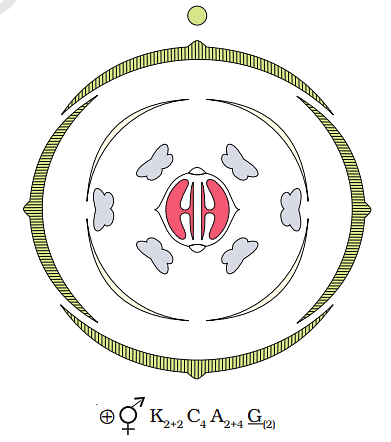 Floral Diagram of Bassicaceae Family
Floral Diagram of Bassicaceae Family
Solanaceae
The Solanaceae family, also known as the potato family, includes around 2000 species of dicotyledonous plants. It belongs to the order Solanales and has the following important characteristics:
Vegetative Characters
- Root System: Taproot system.
- Stem: Can be erect or climbing; Solanaceae includes herbs, shrubs, small trees, and climbers.
- Leaves: Alternately arranged, simple or pinnately compound (rarely); without stipules; veins form a network-like pattern.
Floral Characters
- Inflorescence: Can be racemose (terminal or axillary raceme) or cymose (solitary in Solanum).
- Flower: Complete, bisexual, regular (actinomorphic), with sepals and petals arranged below the ovary (hypogynous).
- Calyx: Composed of five sepals that are fused (gamosepalous); sepals overlap in a valvate manner during bud development (valvate aestivation).
- Corolla: Composed of five petals that are fused (gamopetalous); petals overlap in a valvate manner during bud development (valvate aestivation).
- Androecium: Composed of five stamens that are attached to the petals (epipetalous); anthers are attached at the base (basifixed).
- Gynoecium: Syncarpous (composed of fused carpels), bicarpellary (consisting of two carpels), bilocular (with two chambers in the ovary), with superior ovary (above the attachment of other floral parts), and axile placentation (ovules attached to the central axis of the ovary).
- Fruit: Can be a berry or a capsule.
- Seed: Numerous, containing endosperm (stored food for the developing embryo).
- Floral Formula:

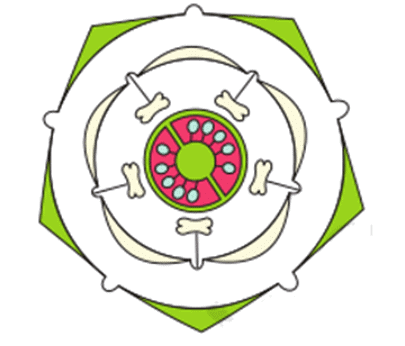 Floral Diagram of Solanaceae Family
Floral Diagram of Solanaceae Family
Economic Importance
Plants belonging to the Solanaceae family have significant economic importance, including:
- Food sources: Examples include tomatoes, eggplants (brinjal), and potatoes.
- Spice sources: Examples include chili peppers.
- Ornamental plants: Examples include petunias.
- Medicinal plants: Examples include belladonna and ashwagandha.
|
180 videos|367 docs|148 tests
|
FAQs on Morphology of Flowering Plants Chapter Notes - Biology Class 11 - NEET
| 1. What are the main parts of a flowering plant? |  |
| 2. How does the root system benefit a flowering plant? |  |
| 3. What is the function of the inflorescence in flowering plants? |  |
| 4. How do flowers contribute to the life cycle of flowering plants? |  |
| 5. What is the significance of seeds in flowering plants? |  |























